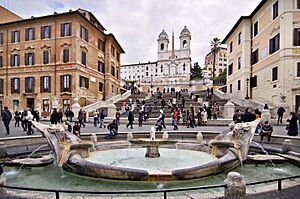Babington's tea room facts for kids
Babington's tea room is a famous English tea shop in Rome, Italy. It opened way back in 1893, right at the bottom of the famous Spanish Steps in the Piazza di Spagna. It's known for its traditional English teas and treats.
Contents
The Story of Babington's Tea Room
How It All Started
Two adventurous young women, Isabel Cargill and Anna Maria Babington, started Babington's tea room in 1893. Isabel was from Scotland, and Anna Maria was from England. They used all their savings, about 100 pounds, to open a place where English-speaking visitors in Rome could enjoy tea and read.
Back then, drinking tea wasn't popular in Italy; you could only buy it in pharmacies! But Babington's was a big hit right away. Many English travelers were visiting Rome on their "Grand Tour" (a long trip to learn about art and culture). Rome was also celebrating important events, like a big Jubilee and a royal wedding, which brought many visitors.
Moving to a New Home
The tea room first opened on Via dei Due Macelli, a street near the Piazza di Spagna. Because it was so popular, the owners decided to move to a bigger and better spot at Piazza di Spagna 23. This new location is on the ground floor of a beautiful building from the 1700s. From here, you can see the famous Spanish Steps and the Trinità dei Monti church.
This building was originally the stables for an old palace designed by Francesco De Sanctis. He was the same architect who designed the Spanish Steps! The new tea room was decorated very nicely. An English newspaper in Rome called it a favorite spot "where ladies or gentlemen, hard at work sightseeing could go to refresh themselves with a comforting cup of tea."
Through Challenging Times
During the First World War, life in Rome became difficult, but the tea room managed to stay open. Isabel's sister, Annie, invested her own savings to give the tea room a fresh new look. Anna Maria Babington moved to Switzerland because she was not well, and she passed away in 1929.
Even during the Second World War, when things were tough for English businesses, Babington's stayed open. Its English sign and bronze letters were a clear sign of its strong spirit.
Famous Visitors
In the 1950s and 1960s, when the Cinecittà film studios were very busy, many movie stars and famous people visited Babington's. Some even became regular customers! You might have seen stars like Richard Burton, Liz Taylor, Charlton Heston, Robert Taylor, Peter Ustinov, and Audrey Hepburn there. Even the famous filmmaker Federico Fellini enjoyed visiting.
Today's Babington's
Today, Babington's still serves delicious teas, like their special Victoria Afternoon Tea. One of their tea blenders, Melania Francis Lopez, even created a special "Royal wedding blend."
Babington's has survived two world wars, the rise of fast food restaurants, and many economic challenges. It has become a well-loved place in Rome and a popular spot for tourists. The tea room is now run by the fourth generation of Isabel Cargill's family.
For the past 50 years, Babington's has also had a special cat guest named Mascherino. Mascherino was a stray cat adopted by the waitresses after the Second World War, and he became a beloved part of the tea room family.


